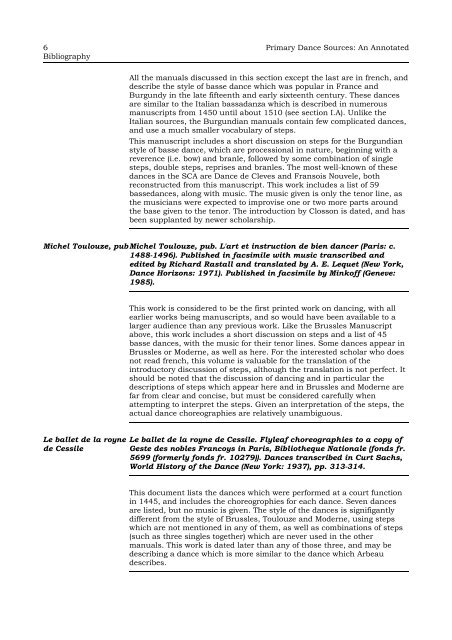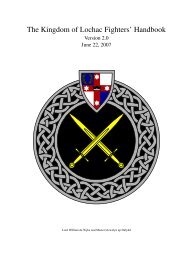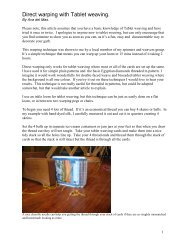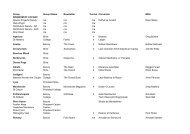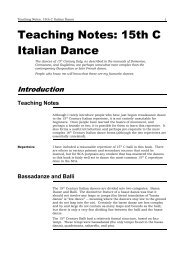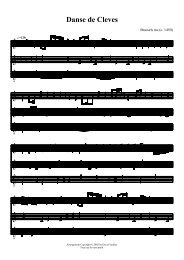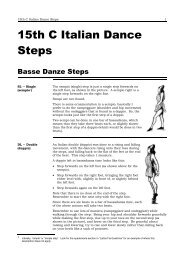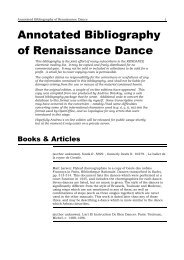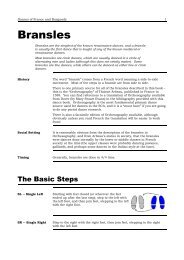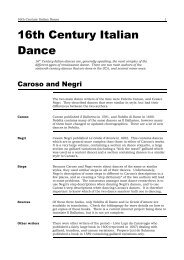Primary Dance Sources: An Annotated Bibliography
Primary Dance Sources: An Annotated Bibliography
Primary Dance Sources: An Annotated Bibliography
Create successful ePaper yourself
Turn your PDF publications into a flip-book with our unique Google optimized e-Paper software.
6 <strong>Primary</strong> <strong>Dance</strong> <strong>Sources</strong>: <strong>An</strong> <strong>An</strong>notated<br />
<strong>Bibliography</strong><br />
All the manuals discussed in this section except the last are in french, and<br />
describe the style of basse dance which was popular in France and<br />
Burgundy in the late fifteenth and early sixteenth century. These dances<br />
are similar to the Italian bassadanza which is described in numerous<br />
manuscripts from 1450 until about 1510 (see section I.A). Unlike the<br />
Italian sources, the Burgundian manuals contain few complicated dances,<br />
and use a much smaller vocabulary of steps.<br />
This manuscript includes a short discussion on steps for the Burgundian<br />
style of basse dance, which are processional in nature, beginning with a<br />
reverence (i.e. bow) and branle, followed by some combination of single<br />
steps, double steps, reprises and branles. The most well-known of these<br />
dances in the SCA are <strong>Dance</strong> de Cleves and Fransois Nouvele, both<br />
reconstructed from this manuscript. This work includes a list of 59<br />
bassedances, along with music. The music given is only the tenor line, as<br />
the musicians were expected to improvise one or two more parts around<br />
the base given to the tenor. The introduction by Closson is dated, and has<br />
been supplanted by newer scholarship.<br />
Michel Toulouze, pub Michel Toulouze, pub. L'art et instruction de bien dancer (Paris: c.<br />
1488-1496). Published in facsimile with music transcribed and<br />
edited by Richard Rastall and translated by A. E. Lequet (New York,<br />
<strong>Dance</strong> Horizons: 1971). Published in facsimile by Minkoff (Geneve:<br />
1985).<br />
This work is considered to be the first printed work on dancing, with all<br />
earlier works being manuscripts, and so would have been available to a<br />
larger audience than any previous work. Like the Brussles Manuscript<br />
above, this work includes a short discussion on steps and a list of 45<br />
basse dances, with the music for their tenor lines. Some dances appear in<br />
Brussles or Moderne, as well as here. For the interested scholar who does<br />
not read french, this volume is valuable for the translation of the<br />
introductory discussion of steps, although the translation is not perfect. It<br />
should be noted that the discussion of dancing and in particular the<br />
descriptions of steps which appear here and in Brussles and Moderne are<br />
far from clear and concise, but must be considered carefully when<br />
attempting to interpret the steps. Given an interpretation of the steps, the<br />
actual dance choreographies are relatively unambiguous.<br />
Le ballet de la royne<br />
de Cessile<br />
Le ballet de la royne de Cessile. Flyleaf choreographies to a copy of<br />
Geste des nobles Francoys in Paris, Bibliotheque Nationale (fonds fr.<br />
5699 (formerly fonds fr. 10279)). <strong>Dance</strong>s transcribed in Curt Sachs,<br />
World History of the <strong>Dance</strong> (New York: 1937), pp. 313-314.<br />
This document lists the dances which were performed at a court function<br />
in 1445, and includes the choreogrophies for each dance. Seven dances<br />
are listed, but no music is given. The style of the dances is signifigantly<br />
different from the style of Brussles, Toulouze and Moderne, using steps<br />
which are not mentioned in any of them, as well as combinations of steps<br />
(such as three singles together) which are never used in the other<br />
manuals. This work is dated later than any of those three, and may be<br />
describing a dance which is more similar to the dance which Arbeau<br />
describes.


